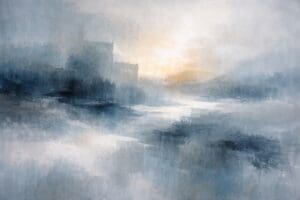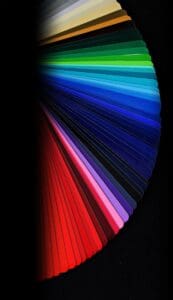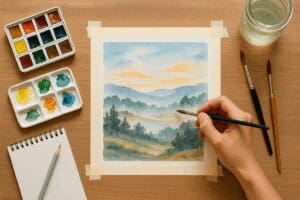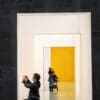The Delicate Beauty of Pastel Art: Blending and Layering Techniques
Pastel art, with its vibrant hues and soft, velvety texture, has captivated artists and art lovers for centuries. From the delicate portraits of Edgar Degas to the expressive landscapes of Mary Cassatt, pastels have played a significant role in the art world. In this post, we will delve into the enchanting world of pastel art, focusing on the blending and layering techniques that bring these works to life. Whether you are a seasoned artist or a beginner, understanding these techniques will enhance your appreciation and execution of pastel art.
What Makes Pastel Art Unique?
Pastel art stands out for its unique qualities. Unlike other mediums, pastels offer a direct way to apply pure pigment to a surface, resulting in intense, luminous colors. The medium’s tactile nature allows for a wide range of textures, from soft and smooth to rough and textured. The richness of color and the ability to blend seamlessly make pastels an attractive choice for artists seeking to capture the subtle nuances of light and shadow.
Types of Pastels
There are several types of pastels, each with its own characteristics:
- Soft Pastels: Known for their vibrant colors and ease of blending, soft pastels are ideal for creating smooth transitions and detailed work.
- Hard Pastels: These are firmer and produce less dust, making them suitable for fine lines and details.
- Oil Pastels: Offering a buttery texture, oil pastels are great for bold, impasto effects and resist smudging once applied.
- Pastel Pencils: Combining the convenience of a pencil with the richness of pastel, these are perfect for intricate work and fine details.
Blending Techniques in Pastel Art
Blending is a fundamental technique in pastel art that helps create smooth transitions between colors, adding depth and realism to your artwork. Here are some effective blending techniques:
Finger Blending
One of the most intuitive ways to blend pastels is using your fingers. The natural oils on your skin help smooth out the pigments, creating a soft, even gradient. However, this method can also transfer oils from your skin to the paper, potentially affecting the longevity of your work. It’s a good idea to keep a cloth handy to wipe your fingers periodically.
Blending Stumps and Tortillons
Blending stumps and tortillons are excellent tools for achieving fine, controlled blends. These tools are made of tightly rolled paper and can be used to blend small areas or add intricate details. Simply rub the tool over the pastel to smooth out the colors.
Brushes and Sponges
Soft brushes and sponges can also be used for blending pastels. They are particularly useful for covering large areas quickly and creating a soft, diffused effect. Experiment with different brush shapes and sponge textures to see what works best for your style.
Layering for Depth and Texture
Layering is another crucial technique in pastel art that allows you to build depth, texture, and richness in your artwork. By applying multiple layers of pastel, you can create complex, vibrant colors and intricate details.
Underpainting
Underpainting involves laying down a base layer of color to establish the basic values and composition of your piece. This initial layer can be done with hard pastels or pastel pencils, providing a framework for subsequent layers. An underpainting can also be created using watercolor or acrylic paint, especially when working on a larger piece.
Scumbling
Scumbling is a technique where you lightly drag a pastel stick over an existing layer, allowing the underlying color to show through. This creates a textured, broken color effect that adds visual interest and depth. Use a light touch and experiment with different colors to see the unique effects you can achieve.
Feathering
Feathering involves applying short, directional strokes of pastel to build up layers of color and texture. This technique is particularly useful for depicting fur, hair, or other textured surfaces. Vary the length and direction of your strokes to create a natural, realistic appearance.
Glazing
Glazing is the process of applying a thin, transparent layer of pastel over a dry layer to alter its color and appearance. This technique can be used to adjust the overall tone of your artwork or to create subtle color shifts. Use soft pastels for glazing, as they blend easily and produce smooth, even layers.
Choosing the Right Paper
The choice of paper can significantly impact the final outcome of your pastel artwork. Pastel papers come in a variety of textures and colors, each offering different benefits:
- Textured Paper: Papers with a rough texture, such as sanded paper or pastel board, hold more pigment and allow for more layers. This type of paper is ideal for detailed work and vibrant colors.
- Smooth Paper: Smooth papers, like Bristol board, are suitable for fine details and soft blending. However, they hold less pigment and may require fixatives to prevent smudging.
- Colored Paper: Using colored paper can add depth and mood to your artwork. Choose a color that complements your subject and enhances the overall composition.
Fixatives and Preservation
Pastel artworks are delicate and can smudge easily, so proper preservation is essential. Fixatives are sprays that help set the pastel particles and reduce smudging. There are two types of fixatives:
- Workable Fixatives: These allow you to continue working on your piece after application. They are useful for building up multiple layers without disturbing the underlying work.
- Final Fixatives: These are used once your artwork is complete to protect it from smudging and dust. Be cautious when using final fixatives, as they can alter the colors and texture of your artwork.
Apply fixatives in a well-ventilated area and follow the manufacturer’s instructions. Hold the can at least 12 inches away from your artwork and spray in a sweeping motion to ensure even coverage.
Exploring Pastel Techniques: Step-by-Step
Step 1: Sketch Your Composition
Begin with a light sketch of your composition using a pastel pencil or hard pastel. This initial sketch will serve as a guide for your painting. Focus on capturing the basic shapes and proportions of your subject.
Step 2: Establish Values with an Underpainting
Next, create an underpainting to establish the basic values and tones of your composition. Use hard pastels or pastel pencils for this step, applying light layers of color. Blend the underpainting using your preferred blending technique to create a smooth base for subsequent layers.
Step 3: Build Up Layers of Color
Once your underpainting is complete, start building up layers of color with soft pastels. Use a variety of blending and layering techniques to create depth and texture. Experiment with scumbling, feathering, and glazing to achieve the desired effects.
Step 4: Add Details and Highlights
As you build up your layers, add fine details and highlights using pastel pencils or hard pastels. Focus on areas that require precision, such as facial features, hair, or intricate textures. Use a light touch and blend as needed to create a natural, realistic appearance.
Step 5: Apply Fixative
Once you are satisfied with your artwork, apply a fixative to protect it from smudging. Use a workable fixative if you plan to add more layers, or a final fixative if your piece is complete. Allow the fixative to dry completely before framing or displaying your artwork.
Learning from the Masters
Studying the works of master pastel artists can provide valuable insights and inspiration. Here are a few notable pastel artists whose techniques are worth exploring:
- Edgar Degas: Known for his delicate portraits and ballerina studies, Degas mastered the use of pastels to capture the subtle play of light and shadow. His work demonstrates the power of blending and layering to create depth and realism.
- Mary Cassatt: A prominent Impressionist artist, Cassatt used pastels to create tender, intimate portraits of women and children. Her work highlights the versatility of pastels in capturing emotion and expression.
- Jean-Baptiste-Siméon Chardin: Chardin’s still life pastels showcase his ability to create rich, textured surfaces through meticulous layering and blending. His work is a testament to the depth and complexity that can be achieved with pastels.
Resources for Further Learning
For those interested in further exploring pastel art, there are numerous resources available:
- Pastel Society of America: The PSA offers workshops, exhibitions, and resources for pastel artists. Visit their website for more information.
- International Association of Pastel Societies: IAPS provides a wealth of resources, including workshops, competitions, and exhibitions. Learn more on their website.
- Online Tutorials and Courses: Websites like Skillshare and Udemy offer a variety of online courses on pastel techniques and art fundamentals.
Conclusion
The delicate beauty of pastel art lies in its unique ability to capture light, color, and texture with unparalleled richness. By mastering blending and layering techniques, you can unlock the full potential of this versatile medium and create stunning, evocative works of art. Whether you are an aspiring artist or a seasoned professional, exploring the world of pastels will undoubtedly enhance your artistic journey.
By exploring the delicate beauty of pastel art and mastering these techniques, you’ll be well on your way to creating your own vibrant, captivating pieces. Happy painting!
*For collaborations, art features, or inquiries, please contact us at [email protected]. Don’t forget to follow us on Instagram, Facebook, Twitter.
Disclaimer: The views and opinions expressed in this article do not necessarily reflect the official policy or position of Irish Artmart.




